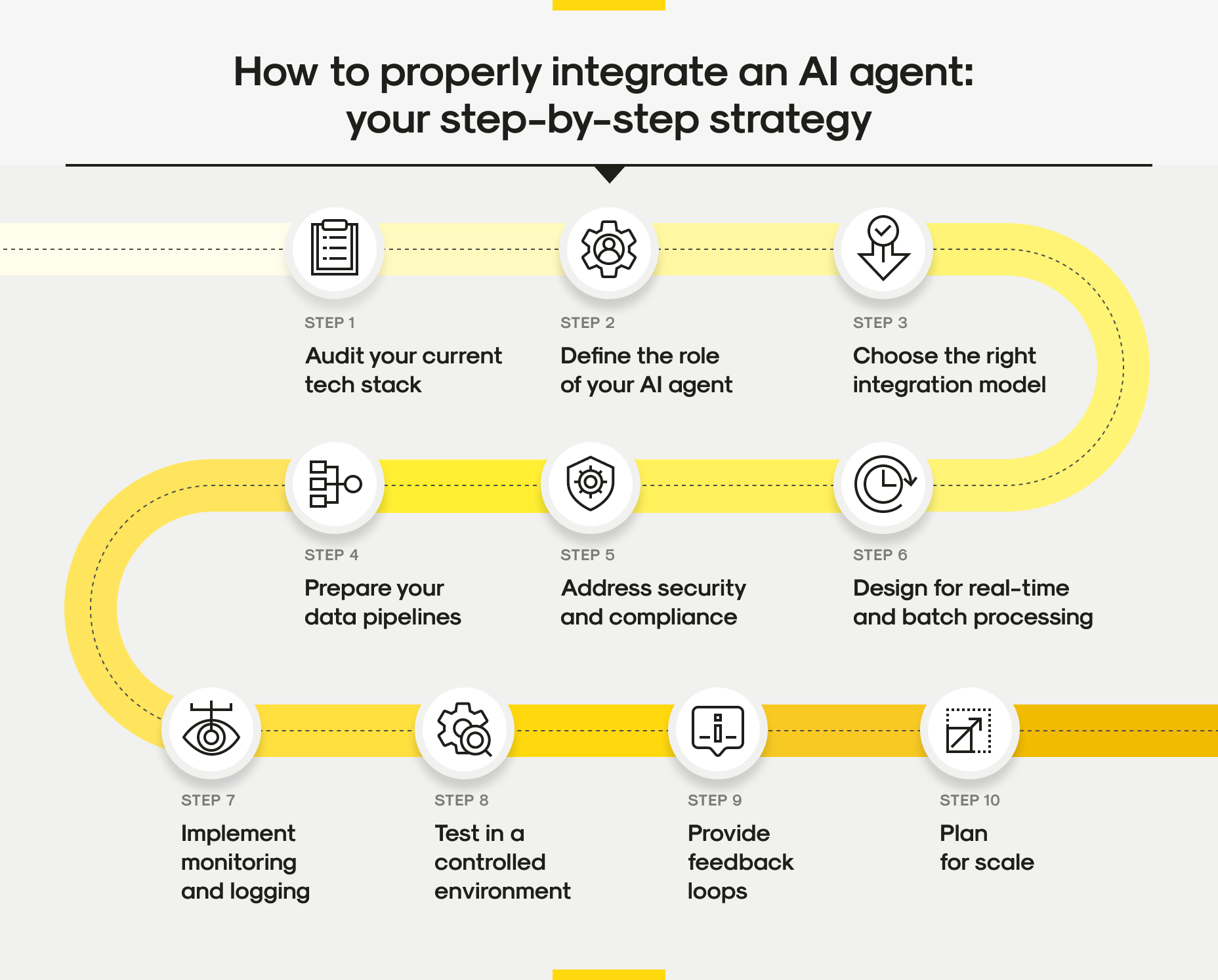AI agents are no longer something futuristic: they’re the muscle behind modern automation, customer support, and decision-making systems. Whether it’s streamlining workflows or powering smart assistants, drive tangible value. But here’s the catch: they don’t operate in a vacuum. AI agents must work hand-in-hand with your existing tech stack to deliver their full potential.
Sounds easy, huh? Well, integrating AI into your current ecosystem is part art, part science, and it requires more than just duct tape, so to speak, and a hopeful attitude. Let’s break down how to do it right, without triggering a digital meltdown.
Here’s what you’ll learn in this article:
- Why integrating AI agents into your website gives you a competitive edge
- What platforms and tools can you use to build and deploy AI agents
- A step-by-step strategy to integrate AI agents into your existing tech stack
- How to avoid common integration pitfalls (and fix them fast)
- The different types of AI agents you can implement, from virtual assistants to financial advisors
- How the Mitrix team can help you design, deploy, and scale AI agents tailored to your business needs
Why integrate AI agents in the first place?
Before we plunge into details, let’s address this question. The simple answer would be that your website deserves more than just a contact form. Integrating AI agents into your website unlocks a whole new level of user engagement, automation, and insight. Here’s why it’s a smart move:
24/7 support
AI chatbots and virtual assistants can handle customer inquiries around the clock. Whether it’s midnight or Monday morning, users get instant responses, and you don’t need to scale your support team. According to Zendesk, AI agents are now capable of handling up to 80% of all customer service interactions on their own.
Faster conversions
AI agents can guide users through your site, recommend products or services, and even nudge them toward making a purchase or booking a demo. Think of them as your high-performing sales team, if you will.
Better personalization options
Your AI agent can tap into user behavior and data to deliver personalized experiences, from tailored content recommendations to dynamic pricing models. That’s a top-tier user experience without the enterprise-level price tag. For instance, 54% of companies worldwide now use conversational AI to deliver personalized customer service.
Lower operational costs
Automating repetitive tasks like answering FAQs, qualifying leads, or scheduling meetings reduces human workload. Less grunt work equals more time for your team to focus on high-value activities. In 2025, companies leveraging AI-powered virtual agents can slash customer service costs by as much as 30%.
Data collection
AI agents can gather feedback, detect pain points, and monitor user sentiment during interactions, all without adding friction to the user journey.
Brand differentiation
Let’s be honest: websites start to blur together. But a helpful, responsive, smart AI agent? That’s something users remember and talk about.
Choosing the platform
Before diving into code, picking the right AI agent platform is key. From fully managed ecosystems to open-source frameworks, there’s a broad range of options depending on how much control, customization, or speed you need. Here’s a breakdown of some popular choices:
- OpenAI API
OpenAI provides robust APIs that integrate smoothly with languages like Python or JavaScript. This gives you direct access to powerful language models, perfect for building intelligent, conversational agents. - OutSystems AI agent builder
OutSystems offers a low-code environment with built-in GenAI tools. You can either plug into pre-trained models or hook into third-party services using API integrations if you need rapid prototyping with minimal engineering overhead. - Google Dialogflow
A trusted name in conversational AI, Dialogflow is great for building agents that handle natural language in both voice and chat formats. It’s especially useful if you’re aiming for customer support bots or voice assistants. - DigitalOcean GenAI Platform
This managed solution streamlines the entire AI development cycle, from model training to deployment. It’s a solid choice if you want full-stack AI capabilities without the hassle of infrastructure setup. - Open-Source Alternatives
If you want total control, consider open-source frameworks like Rasa or Hugging Face Transformers. These platforms are highly customizable, can be deployed on your servers, and are backed by active developer communities, ideal for privacy-conscious or highly specialized applications.
Choosing the right platform isn’t just a technical decision: it sets the stage for how fast you can iterate, how much you can customize, and how scalable your AI agent will be.
Integrating AI agents: your step-by-step strategy
Integrating AI agents into your tech stack isn’t just about plugging in a chatbot and calling it a day: instead, it requires a strategic approach. Here’s a step-by-step strategy for you.

How to integrate an AI agent
1. Audit your current tech stack
Before implementing an AI agent, you need to know all the details: list every tool, system, API, and data source currently in play. This includes:
- CRMs (e.g., Salesforce, HubSpot)
- ERPs
- Databases (SQL, NoSQL, data lakes)
- Cloud infrastructure (AWS, Azure, GCP)
- Messaging platforms (Slack, MS Teams)
- Customer support systems (Zendesk, Intercom)
- Internal APIs and third-party integrations
Once you’ve got the lay of the land, identify where the AI agent is supposed to add value. Are you automating customer queries? Or, maybe, running background data analysis? Making decisions in real-time? This kind of audit will help clarify the integration points and prepare you for the next step.
2. Define the role of your AI agent
Spoiler alert: “AI agent” isn’t a job title. It’s a flexible term that could mean anything from a chatbot to a predictive analytics engine. To integrate it properly, you need to define what it’s doing:
- Task automation. Answering FAQs, managing support tickets, handling orders, etc.
- Data processing. Scrubbing, organizing, analyzing, and visualizing large volumes of data.
- Decision-making. Providing real-time recommendations, forecasts, or risk assessments.
- User interaction. Engaging with users in natural language, acting as a virtual assistant.
The clearer the role, the easier it is to align the agent with the right APIs, databases, and workflows.
3. Choose the right integration model
Depending on your stack and goals, you’ll choose one or more of the following approaches:
API-based integration
This is the most common and flexible method. Your AI agent communicates with existing systems via APIs: sending, receiving, and processing data in real time.
Best for: Scenarios where your systems already expose RESTful or GraphQL APIs.
Tip: Use an API gateway to manage traffic, monitor performance, and ensure security.
Middleware integration
Middleware acts as a translator between your AI agent and legacy systems. Think of it as a universal adapter.
Best for: Connecting with older systems that don’t support modern APIs or require message brokering (e.g., using Kafka, RabbitMQ, or enterprise service buses).
Plugin or SDK integration
Some platforms (like Salesforce or Shopify) allow AI agents to be embedded via plugins or SDKs.
Best for: AI agents that enhance the functionality of existing SaaS tools without deep custom development.
4. Prepare your data pipelines
An AI agent is only as smart as the data it gets. Integrating it with your data pipeline is a must. That includes:
- Input data. Structured (databases), semi-structured (CSV, JSON), and unstructured (text, audio, video).
- Cleaning and normalization. Your agent needs consistent, clean data formats to learn and act effectively.
- Data storage. Choose where data should live: on-premises or cloud-based, and ensure your agent has secure, compliant access.
Pro tip: Use ETL (Extract, Transform, Load) tools to bridge the gap between raw data and what your agent needs.
5. Address security and compliance
Your AI agent will likely be touching sensitive data. Make sure your integration doesn’t become a backdoor for cyber gremlins.
Checklist:
- Encrypted communication between systems (TLS, HTTPS)
- Role-based access control (RBAC)
- Compliance with GDPR, HIPAA, or other relevant laws
- Audit trails and logging for AI actions
- Secure APIs (tokens, OAuth2, API keys)
Also, validate how your AI agent logs and stores data, especially if it’s using it to learn over time.
6. Design for real-time and batch processing
Some AI functions need to happen live (e.g., customer support), while others are best handled in batches (e.g., overnight data analysis). Design your integration accordingly.
- Real-time: Webhooks, message queues, socket connections.
- Batch: Scheduled ETL jobs, cron tasks, and serverless functions triggered by events.
Match the response time requirements to the agent’s role. You don’t want a chatbot making your customers wait 15 seconds for a greeting.
7. Implement monitoring and logging
Integration without monitoring is like flying blind. Set up real-time dashboards to track:
- API call success/failure rates
- Latency
- Data volumes processed
- Error rates and exceptions
- Resource utilization (CPU, memory, I/O)
- Security alerts and suspicious activity
As a best practice, centralize logs from all integrated systems for easier troubleshooting and correlation.
8. Version control and CI/CD
Treat your integration code like any other critical asset: version it, test it, and automate deployments.
- Use Git or similar tool for code management
- Automate testing for every change (unit, integration, functional)
- Create CI/CD pipelines for automated deployments (e.g., Jenkins, GitLab CI)
The goal is to make integration updates predictable, reversible, and fast.
Common integration pitfalls (and how to fix them)
The “Spaghetti Stack”
Symptom: Point-to-point integrations with no clear structure or governance. When one system changes, everything breaks.
Solution: Use an integration platform as a service (iPaaS) to centralize integration logic, enforce standards, and improve visibility.
The “Data Swamp”
Symptom: Your AI agent is drowning in outdated, inconsistent, or irrelevant data.
Solution: Build robust data governance policies and invest in tools for data quality, cleansing, and lineage tracking.
The “Black Box”
Symptom: The AI agent’s decision-making is opaque. No one knows why it’s doing what it’s doing.
Solution: Ensure your platform provides explainability features and require the agent to log its reasoning for every action.
The “Compliance Train Wreck”
Symptom: Your integration violates data privacy laws or industry regulations.
Solution: Engage legal and security experts early, and bake compliance checks into your integration pipelines.
The “Performance Cliff”
Symptom: The integration works fine in testing but grinds to a halt under real-world loads.
Solution: Profile your integration, identify bottlenecks, and scale resources appropriately. Use caching, queuing, and load balancing to optimize performance.
Types of AI agents you can implement
Here’s a look at the different types of AI agents available and how they deliver value across different domains:
Customer service agents
These agents provide 24/7 support, answer FAQs, resolve common issues, and enhance customer satisfaction. They can be integrated into websites, messaging platforms, or voice assistants.
Healthcare assistants
These agents offer preliminary symptom assessments, schedule appointments, provide medical information, and remind patients about medication. They can be integrated into patient portals, telehealth platforms, or wearable devices.
Financial advisors
These agents deliver personalized investment advice, monitor market trends, provide financial planning, and manage portfolios. They can be integrated into banking apps, wealth management platforms, or robo-advisors.
Sales agents
These agents identify and qualify leads, automate sales processes, personalize outreach, and manage customer relationships. They can be integrated into CRMs, marketing automation platforms, or sales intelligence tools.
Data analysis agents
These agents process and interpret large datasets, deliver actionable insights, automate reporting, and assist in strategic decision-making. They can be integrated into data warehouses, BI platforms, or analytics dashboards.
Virtual assistants
These agents organize schedules, manage tasks, provide reminders, automate workflows, and enhance productivity. They can be integrated into productivity apps, collaboration platforms, or personal devices.
How we can help
Looking to integrate AI agents into your tech stack? We have experience with platforms ranging from OpenAI and Google Dialogflow to open-source frameworks like Rasa and Hugging Face.
With our support, you’re able to:
- Automate processes and streamline workflows
- Enhance customer experience and drive conversions
- Generate real-time insights and make data-driven decisions
- Innovate faster and gain a competitive edge
From strategy and design to development and deployment, we can help you at every stage of the integration journey. Contact us today to discuss how Mitrix can help you unlock the full potential of AI.
Wrapping up
The integration of AI agents isn’t just a nice-to-have feature, it’s the backbone of any smart, adaptable website. By choosing the right platforms, following a structured strategy, and avoiding common pitfalls, you set the stage for next-level user engagement, automation, and insight.
However, the most important ingredient of your digital success is to take the first step. Get in touch to see how our talented team can bring to life your boldest ideas.


